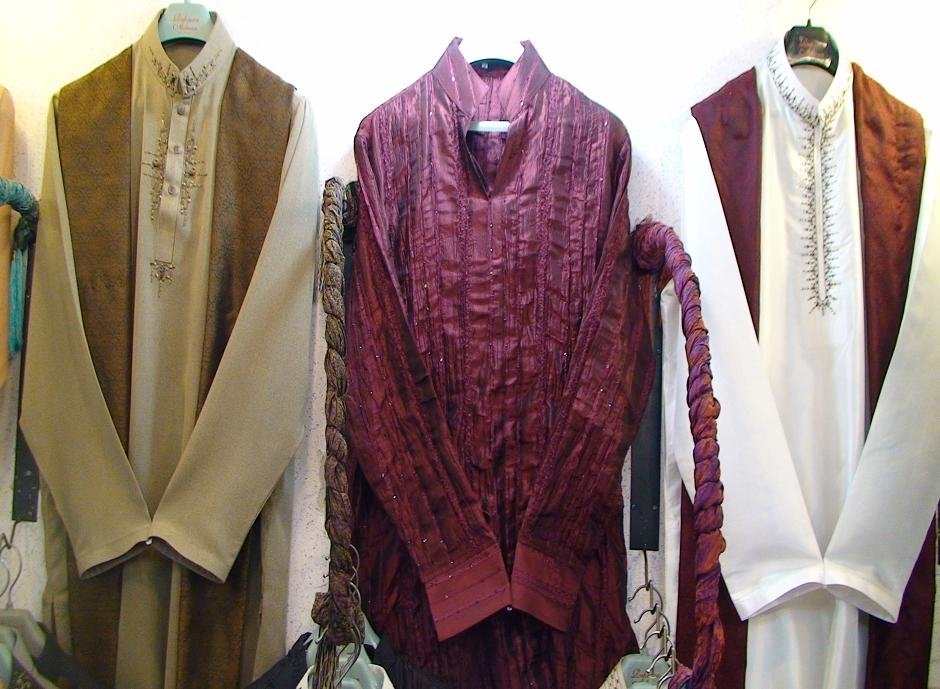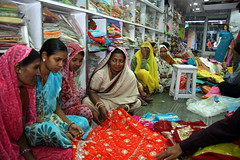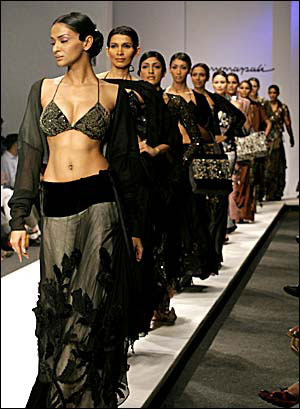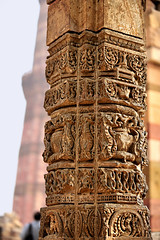 Image by Zahid H Javali via Flickr
Image by Zahid H Javali via Flickr
Among all kind of
Indian saris that come in variety of textures,
colors and designs,
silk saris form an integral part of Indian Fashion
Trends.The Kanjivaram silk sarees are woven from pure mulberry silk.
They are of enviable texture, luster and durability and finish. The
sarees come in an array of dazzling colors and are available in every
imaginable design and variety.The rich weave and feel of kanjivaram
silk saris hold everyone's attention. Be it simple contrast border
silk sarees or those with gold zari dots and patterns, the kanjivaram
silk sari continues to hold place of pride among the various silk
sari-varieties of the country.
Kanjivaram silk is preferred as bridal sarees for its durability and
grandeur in Southern
India.
History of Kanjivaram Silk Sarees
Historical records reveal that it was during the reign of Krishnadeva
Raya that silk
weaving rose to eminence in Kancheepuram. During this
time, the Devanga and Saligar weavers, who were reputed for their
weaving skills in silk transmigrated from
Andhra Pradesh and settled
in Kancheepuram in
Tamil Nadu.The rich kanchipuram silk sarees date
back nearly 400 years when they were woven in the temples. Probably
the most superior and famous of silk in the world is the ‘Kancheepuram
silk’ of Tamil Nadu. The town is also known as ‘Silk city’ because the
main profession of the people living in and around Kancheepuram is
weaving silk sarees. In fact, more than 5000 families are engaged in
the silk industry.
The temple city of
Kanchipuram is renowned from antiquity for its
distinctive weaving style.
The neighboring regions viz. Arani, Kumbakonam and Thirubhavanam also
form an integral part of the silk weaving industry. The mulberry silk
comes from
Karnataka while the gold zari comes from Surat.
Interestingly, since the maximum length on a traditional loom is
18-yard warp, it ensures that not more than 3 silk saris can look
alike. Nimble fingers weave yards of magic with color and design to
give you silk material that can also be fashioned into garments such
as lehengas, pavadais and
salwar kameez.
The unique feature of Kanjivaram silk saris is its special weaving
technique - one that uses three single threads of silk yarn along with
zari. This accounts for its durability and lustre.
The Kanjivaram silk sarees is noted for its double warp and double
weft. In a genuine Kancheepuram silk saree, the border, body and the
pallu are woven separately and then interlocked together. This joint
is woven so strongly that even if the saree tears, the pallu or border
will not detach.
The gold in the motifs in Kanjivaram silk sarees is incorporated by
dipping the silk threads into liquid gold and silver. This enhances
the ethnic beauty and value of silk. Some of the traditional motifs
featured in the Kanjivaram silk sarees are ‘rudraksham’, ‘malli mogu’
and ‘gopuram’, ‘mayilkan’ (peacock’s eye), ‘kuyilkan’ (nightingale
eye) borders.
Contrast colors for pallav and borders are a hallmark with most
Kanjivaram silks. Earlier, designs for these Indian silk sarees were
restricted to conservative stripes or gold dots. Motifs represented
various elements of nature such as birds, leaves and flowers.
Today, the kanjivaram silk saree has undergone a metamorphosis. It has
kept pace with modern prints and its rich and magnificent grandeur
continues to lend a festive touch to any occasion. Today you can find
designer silk sarees with embroidery or even embellished with cystals.
The other popular silk saree varieties are the Benaras silk saris or
Patola silk sarees.
Be it wedding sarees or festive sarees, Indian silk sarees are a class
apart! They are truly fashionable.

![Reblog this post [with Zemanta]](http://img.zemanta.com/reblog_e.png?x-id=97604cc7-97da-4431-9d2f-d193230f9cee)


![Reblog this post [with Zemanta]](http://img.zemanta.com/reblog_e.png?x-id=11d0582b-328b-4e26-8ca8-6b469c3f818a)

![Reblog this post [with Zemanta]](http://img.zemanta.com/reblog_e.png?x-id=bc451e63-976d-4fdb-bc14-8c509bde5734)

![Reblog this post [with Zemanta]](http://img.zemanta.com/reblog_e.png?x-id=9924cf94-2180-4a21-ad96-3953d1f725bf)



![Reblog this post [with Zemanta]](http://img.zemanta.com/reblog_e.png?x-id=f87f4b67-0843-464c-bba6-380775da59e8)


![Reblog this post [with Zemanta]](http://img.zemanta.com/reblog_e.png?x-id=a267b7a2-1c20-4dbf-b317-58dc7823179f)

![Reblog this post [with Zemanta]](http://img.zemanta.com/reblog_e.png?x-id=3b83fc8b-4858-4407-817b-842f9029177a)


![Reblog this post [with Zemanta]](http://img.zemanta.com/reblog_e.png?x-id=8918adba-ec1d-47f1-b1bc-a4a94ba91e1d)


![Reblog this post [with Zemanta]](http://img.zemanta.com/reblog_e.png?x-id=21201e87-80cb-41e9-ac28-706ef1390ac7)


![Reblog this post [with Zemanta]](http://img.zemanta.com/reblog_e.png?x-id=feceeecf-8158-4bef-a069-49fbb09ca5c2)

![Reblog this post [with Zemanta]](http://img.zemanta.com/reblog_e.png?x-id=f372c5f0-cc75-4be9-a6a3-47245120b6c6)

![Reblog this post [with Zemanta]](http://img.zemanta.com/reblog_e.png?x-id=cafe6c84-f41a-4cf5-97e2-dcfcf2426eef)

![Reblog this post [with Zemanta]](http://img.zemanta.com/reblog_e.png?x-id=3f58e6ec-d05b-4db0-85b3-4c677e698b08)









![Reblog this post [with Zemanta]](http://img.zemanta.com/reblog_e.png?x-id=eb349957-f0d1-4dc5-9ded-ef1b1b437ad0)